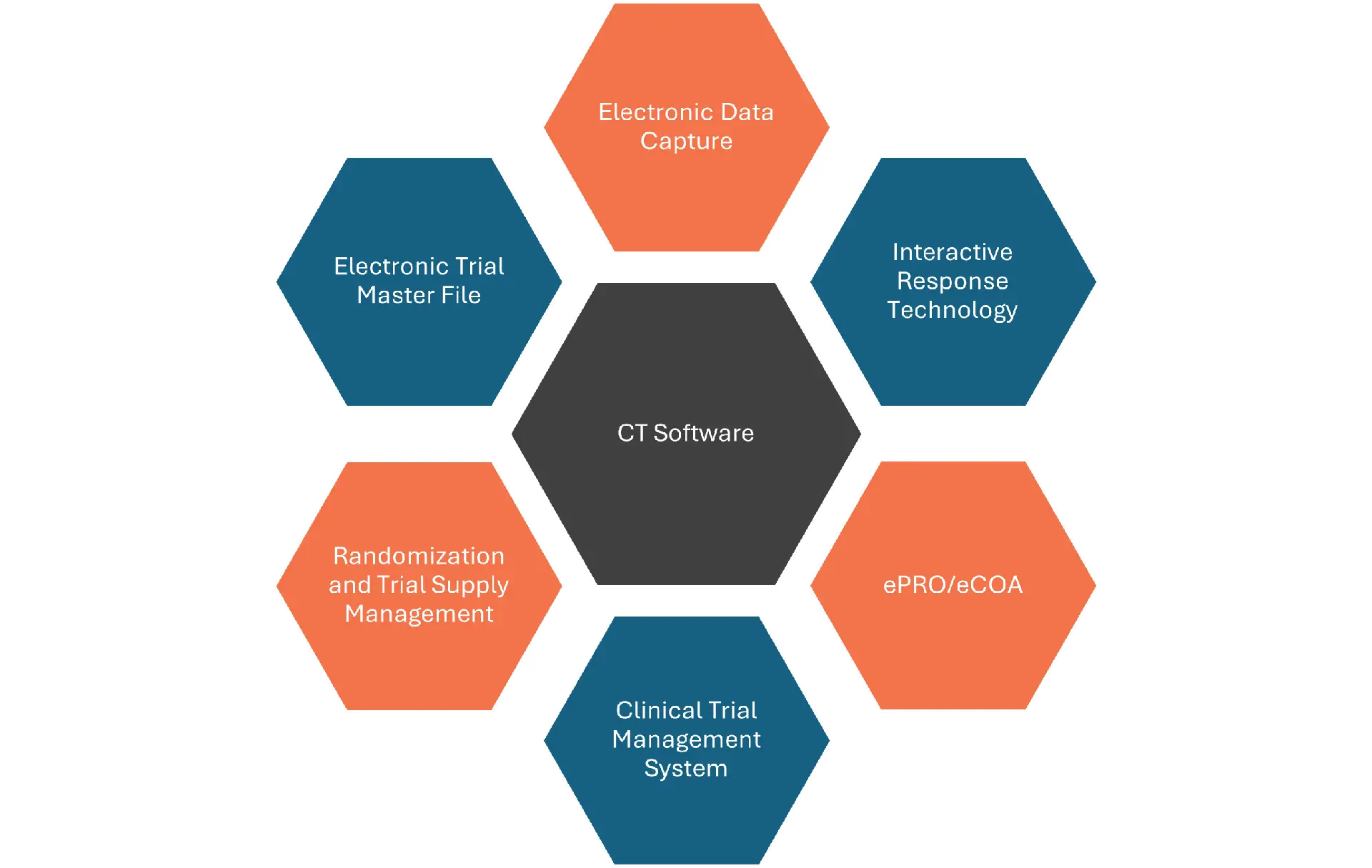IT Solutions for Clinical Trials
In the landscape of clinical trials, different sub-classes of software are available for sponsors, investigators and CROs:
a) Electronic Data Capture (EDC) Systems – software that allows sponsors and CROs to prepare custom electronic case report forms (eCRFs) to collect standardized patient data, manage its cleaning and queries, and ensure regulatory compliance.
b) Clinical Trial Management System (CTMS) – software that assists with planning, tracking, and managing operational aspects of trials, such as study milestones, budgets, timesheets, and invoices.
c) Electronic Trial Master File (eTMF) Systems – software that stores and manages documents according to Good Clinical Practice (GCP) guidelines and regulatory requirements.
d) Randomization and Trial Supply Management (RTSM) / Interactive Response Technology (IRT) – software that handles randomization, supply management, blinding and unblinding processes during the study.
e) Electronic Patient-Reported Outcomes (ePRO) / Clinical Outcome Assessment (eCOA) – software that allows patients electronically capture data regarding their symptoms, health condition, and quality of life via mobile devices, tablets or web applications.
f) eConsent – software that allows electronic gathering of informed consent, by enabling patients to review study information and provide informed consent using digital interfaces, usually including comprehension checks.
g) Safety & Pharmacovigilance Software – software that streamlines adverse event (AE) capture, case processing, signal management, and associated reporting.
h) Data Analytics & Statistical Software – software that helps statisticians and data managers analyse clinical trial data and generate reports.
i) Regulatory Submission & Document Management – software that facilitates creation, review and submission of regulatory documents.
j) Other solutions assisting with clinical trials – software that is not specifically designed with clinical trials in mind, but forms an integral part of the pharmaceutical process. These include Quality Management Systems (QMS), Laboratory Information Management Systems (LIMS), Medical Imaging and Analysis Software, or Data Warehousing and Business Intelligence.
In the following chapters, the first four technologies are described in detail.
- Electronic Data Capture (EDC) Systems
Electronic Data Capture, or EDC, is a type of clinical trial software used to collect, manage and store trial-related data [1]. EDCs have been in use for many years – already in 2009, out of over 250 interviewed sites, over 40% were using the EDC system in their daily work [2], helping teams increase data-gathering efficiency and integrity, as well as emphasizing compliance with regulatory standards. EDC systems are intended to replace paper-based data curation methods, offering certain advantages over the physical counterparts. Possibility to implement automatic data validation and checks increases data accuracy and reduces risk of transcription errors, and real-time access speeds-up trial planning and related activities. EDCs offer the functionality of built-in queries, for data checks, streamlining issue resolution. Moreover, the problematic issues of storing and archiving paper-based records become irrelevant while working with EDCs.
EDCs usually offer a user-friendly interface to build and customize a trial-specific electronic case report (eCRF) allowing to store all trial-related events in designated fields – often, automated filling rules are employed to prevent incorrect entries. Another important function is the embedded audit trail, to capture every change made to the data, ensuring traceability. Last, but not least, EDCs often integrate with other clinical trial software for seamless data flows.
While selecting an EDC, an organization should consider several factors. Its capabilities are of course important, as they must meet trial requirements, but other aspects, like ease of use, scalability and cost must be considered and weighted against each other. Available technical support is also a crucial aspect, allowing avoiding delays and preserving data integrity. Medidata Rave, Oracle InForm, Veeva EDC, Castor EDC, eSOCDAT are some examples of used EDC systems. Several trends are emerging in EDCs, such as incorporation of readable dashboards to flag high-risk data in near real-time, reliance on cloud-based platforms to accommodate remote site management and patient data capture, and using AI for automated data cleaning, predictive analytics, and natural language processing to further reduce manual effort.
- Clinical Trial Management Systems (CTMS)
Clinical Trial Management System (CTMS) is a sub-class of clinical trial software, designed to manage all operational, day-to-day, aspects of a clinical trial, such as study planning, subject tracking, budget and resources, allowing to streamline trial processes, enhance conduct of multiple parallel studies, and ensure compliance with industry regulations.
The core functionalities of a CTMS are [3]:
- Study planning and setup, tracking key timelines and milestones, like first patient first visit etc.
- Site and Investigator Management, allowing to manage contracts, budget, recruitment goals and communication.
- Adverse event reporting.
- Subject recruitment, centralizing the enrolment process for accurate demand forecasting.
- Handling of budget planning, invoices etc.
- Generating reports for stakeholders and to manage risks.
Organizations employ CTMS to reduce administrative burden, automate workflows and increase their operational efficiency. Sponsors and CROs can quickly access and review status of a specific trial under their responsibility, assessing site performance and adjust their planning accordingly. Adequate employment of a CTMS allows to detect issues and inconsistencies, giving a chance to proactively address them before escalation.
CTMS can integrate workflows with EDC and eTMFs, synchronizing enrolment status and key documentation to maintain consistency across platform, or with financial systems to align on budgetary milestones.
Selection of a CTMS should follow a standard selection of a software, weighting its benefits, drawbacks against the costs. Complex solutions may be suitable for some trials, but require more thorough user training, implementation effort and maintenance. Like in many software fields, CTMS providers also spend effort to automate certain tasks with AI, such as forecasts for enrolment, resource needs, and real-time risk-based monitoring. With the rise of decentralized trials, modules that handle virtual visits, remote site staff training, and digital document sharing are being developed, and many solutions try to integrate and end-to-end clinical trial workflow within a CTMS integrating EDC, eTMF and regulatory submission features.
- Electronic Trial Master File (eTMF)
Electronic Trial Master File (eTMF) is a repository of all documents related to a clinical trial that are required to be presented to auditing bodies to prove compliance with regulatory standards, and it organizes, centralizes and tracks these documents, ensuring transparency and readiness for audits or inspections.
eTMF allows to manage documents (upload, categorization, secure storage) with a version control functionality, which retains the history of all the document changes, ensuring that the trial teams use only the latest, approved versions. Usually, eTMFs allow to control access to the approved users, and facilitate collaboration between stakeholders.
Digital eTMF workflows reduce manual handling effort, resource allocation to document handling and alleviate challenges related to physical storage and shipment of paper-based records. Sponsors and CROs can track document completeness, identify gaps, and address risks proactively, streamlining communication via a single source of truth
eTMF systems integrate with CTMS, to synchronise milestones, site data and regulatory status documents for various event triggers related to documents. EDC documents can be stored in eTMF, and accessible from a single platform, and integration with QMS and other regulatory systems aligns clinical trials with the established quality processes, maintaining consistency.
- Randomization and Trial Supply Management (RTSM) and Interactive Response Technology (IRT)
Randomization and Trial Supply Management (RTSM), often delivered through Interactive Response Technology (IRT), is a category of clinical trial software focused on overseeing the random assignment of participants to different treatment arms and ensuring a steady, optimized supply of the investigational products throughout the study. Historically, IRT solutions emerged as phone-based IVRS (Interactive Voice Response Systems), but modern implementations are predominantly web-based. By automating randomization procedures and real-time tracking of drug inventory, these systems help avoid imbalances in patient allocation, reduce manual errors, and significantly improve compliance and audit trails. RTSM/IRT platforms also maintain the blinding of treatment assignments, with emergency unblinding features activated only under specific circumstances, thus safeguarding study integrity.
Another vital function of RTSM/IRT solutions is the handling of drug supply logistics, encompassing packaging, labelling, shipping, and on-site stock management. Through dashboards and predictive analytics, trial teams can monitor the availability of investigational products and anticipate stockouts or overages, leading to a just-in-time supply approach and minimized waste [24]. Many solutions integrate seamlessly with EDC and CTMS platforms, automatically updating patient enrolment status, site inventory levels, and re-supply requests. Examples of RTSM/IRT providers include Almac IXRS, Suvoda IRT, SAP Intelligent Clinical Supply Management, or N-SIDE Supply Optimization, each offering distinct capabilities for randomization algorithms and sophisticated supply chain monitoring. As clinical trials grow more complex and geographically dispersed, effective RTSM/IRT solutions are critical to maintain operational efficiency and uphold data quality standards.
- References
[1] J. Vielhauer et al., “Electronic data capture in resource-limited settings using the lightweight clinical data acquisition and recording system,” Sci Rep, vol. 14, no. 1, Dec. 2024, doi: 10.1038/s41598-024-69550-w.
[2] K. El Emam, E. Jonker, M. Sampson, K. Krleža-Jerić, and A. Neisa, “The use of electronic data capture tools in clinical trials: Web-survey of 259 canadian trials,” J Med Internet Res, vol. 11, no. 1, 2009, doi: 10.2196/jmir.1120.
[3] Y. R. Park et al., “Utilization of a Clinical Trial Management System for the Whole Clinical Trial Process as an Integrated Database: System Development,” J Med Internet Res, vol. 20, no. 4, p. e103, Apr. 2018, doi: 10.2196/jmir.9312.
Read More


